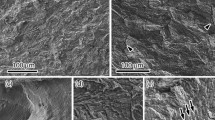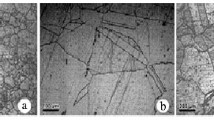Abstract
Hydrogen embrittlement susceptibility, as measured from room temperature precharged tensile specimens, indicates that the type, extent, and morphology of carbide precipitation are all important in determining the degree and mode of degradation. At equivalent charging conditions, embrittlement is virtually eliminated by aging to produce fine scale clustering of Ti(C, N), even when concurrent with cementite precipitation. High temperature aging (> 500 °C) results in exclusive precipitation of the alloy carbide, but also in a total loss of ductility due to a fracture mode transition to intergranular. This is shown to be associated with metalloid (P, S) segregation to grain boundaries accompanying depletion of Ti in solution. Intermediate behavior is observed in microstructures produced by high temperature quenching or aging at temperatures (∼ 400 °C) where only cementite precipitation is observed.
Similar content being viewed by others
References
A. W. Thompson and I. M. Bernstein: “The Role of Metallurgical Variables in Hydrogen Assisted Environmental Fracture”, inAdvances in Corrosion Science and Technology, M. G. Fontana and R. W. Staehle, eds., Plenum Publishing Corp., 1980, vol. 7, pp. 53–175.
H. K. Birnbaum: “Hydrogen Related Failure Mechanisms in Metals”, inEnvironment Sensitive Fracture of Engineering Materials, Z. A. Foroulis, ed., TMS-AIME, Warrendale, PA, 1979, pp. 326–60.
J. P. Hirth:Metall Trans. A, 1980, vol. 11A, pp. 861–90.
I. M. Bernstein and A. W. Thompson:Int. Met. Rev. (Rev 212), 1976, vol. 21, pp. 269–87,
I. M. Bernstein:Mater. Sci. Eng., 1970, vol. 6, pp. 1–19.
H. K. Birnbaum: “Hydrogen Effects on the Fracture of BCC Metals”, inMechanical Properties of BCC Metals, M. Meshii, ed., TMS-AIME, Warrendale, PA, 1982, pp. 153–72.
A. W. Thompson and I. M. Bernstein: “Stress Corrosion Cracking and Hydrogen Embrittlement”, inMetallurgical Treatises, J. K. Tien and J. F. Elliott, eds., TMS-AIME, Warrendale, PA, 1981, pp. 589–601.
Y. Kikuta: inHydrogen Effects in Metals, I. M. Bernstein and Anthony W. Thompson, eds., TMS-AIME, Warrendale, PA, 1981, pp. 755–65.
K. Kiuchi and R. B. McClellan:Acta Metall., 1983, vol. 31, pp. 961–84.
R. Gibala: inStress Corrosion Cracking and Hydrogen Embrittlement of Iron Base Alloys, NACE-5, Houston, TX, 1977, p. 244.
G. M. Pressouyre and I. M. Bernstein:Metall. Trans. A, 1981, vol. 12A, pp. 835–44.
G. M. Pressouyre and I. M. Bernstein:Metall. Trans. A, 1978, vol. 9A, pp. 1571–80.
G. M. Pressouyre and I. M. Bernstein:Corrosion Science, 1978, vol. 18, pp. 819–33.
G. M. Pressouyre and I. M. Bernstein:Acta Metall., 1979, vol. 27, pp. 89–100.
M. F. Stevens, I. M. Bernstein, and W. A. McInteer: inHydrogen Effects in Metals, I. M. Bernstein and Anthony W. Thompson, eds., TMS-AIME, Warrendale, PA, 1981, pp. 795–802.
S. M. Meyers, D. M. Follstaedt, and H. J. Rack:J. Appl. Phys., 1978, vol. 33, pp. 396–98.
J. Pillar, M. K. Miller, and S. S. Brenner:Trans. 29th Field Emission Symp., Gotheburg, Sweden, 1982, pp. 473–80.
H. Erhart, H. J. Grabke, and R. Moller:Arch. Eisenhüttenwesen, 1981, vol. 54, no. 7, pp. 285–89.
J. I. Ustinovshchikov:Acta Metall., 1983, vol. 31, pp. 355–64.
M. F. Stevens: Ph.D. Thesis, Carnegie-Mellon University, Pittsburgh, PA, 1984.
W. C. Leslie:The Physical Metallurgy of Steels, McGraw-Hill Book Co., New York, NY, 1981, p. 201.
G. R. Speich:Trans. AIME, 1969, vol. 245, p. 2553.
L. J. Cuddy, H. E. Knechtel, and W. C. Leslie:Metall. Trans., 1974, vol. 5, pp. 1979–2003.
W. S. Owen:Trans. Am. Soc. Met., 1954, vol. 46, p. 812.
R. W. K. Honeycombe:Steels—Microstructure and Properties, Edward Arnold and ASM, Metals Park, OH, 1981, p. 152.
L. Meyer, F. Heisterkamp, and D. Lauterbora: inProcessing and Properties of Low Carbon Steel, TMS-AIME, 1973, pp. 279–320.
Anthony W. Thompson and J. C. Chesnutt:Metall. Trans. A, 1979, vol. 10A, pp. 1193–96.
M. Cornet and S. Talbot-Besnard: in “Hydrogen in Metals”,Proc. 2nd JIM Int. Symp., Suppl. to Trans. Japan Inst. Met., 1980, p. 545.
K. Yoshino and C.J. McMahon, Jr.:Metall. Trans., 1974, vol. 5, p. 363.
T. Tabata and H. K. Birnbaum:Scripta Met., 1984, vol. 18, pp. 231–36.
T. Takeyama and H. Takahashi: “Nucleation of Crack and Microstructure Induced by Hydrogen”, inMechanical Properties of BCC Metals, M. Meshii, ed., TMS-AIME, Warrendale, PA, 1982, pp. 153–72.
R. C. Frank: inInternal Stresses and Fatigue in Metals, G. M. Rossweiler and W. L. Grube, eds., Elsevier, New York, NY, 1959, pp. 411, 424.
J. A. Donovan:Metall. Trans. A, 1976, vol. 7A, pp. 145–49.
C. Hwang: Ph.D. Thesis, Carnegie-Mellon University, Pittsburgh, PA, 1984.
Y. Takeda and C. J. McMahon, Jr.:Metall. Trans. A, 1981, vol. 12A, pp. 1255–66.
I. M. Bernstein:Metall. Trans., 1970, vol. 1, p. 3143.
F. Nakasato and I. M. Bernstein:Metall. Trans. A, 1978, vol. 9A, pp. 1317–26.
H. Kimura, H. Matsui, S. Takaki, A. Kimura, and K. Oguri: inMechanical Properties of BCC Metals, M. Meshii, ed., TMS-AIME, Warrendale, PA, 1982, pp. 125–33.
B. Craig and G. Krauss: inHydrogen Effects in Metals, I.M. Bernstein and Anthony W. Thompson, eds., TMS-AIME, Warrendale, PA, 1981, pp. 795–802.
T. D. Lee, T. Goldenberg, and J. P. Hirth:Metall. Trans., 1974, vol. 10, pp. 439–48.
T. Goldenberg, T. D. Lee, and J. P. Hirth:Metall. Trans. A, 1978, vol. 9A, pp. 1663–71.
H. Matsui, S. Moriya, and H. Kimura: in “Strength of Metals and Alloys”,Proc. 4th Int. Conf., 1976, vol. 1, p. 291.
H. Kimura, H. Matsui, and S. Moriya:Scripta Met., 1977, vol. 11, p. 473.
W. Steven and K. Balajiva:J. Iron Steel Inst., 1959, vol. 178, p. 141.
C.J. McMahon:Proc. 4th Bolton Landing Conf., J. L. Walter, J. H. Westbrook, and D. A. Woodfrod, eds., Claitor’s Pub. Division, 1975, pp. 525–52.
M. Guttman:Met. Sci., 1976, vol. 10, pp. 337–41.
Z. Qu and C.J. McMahon, Jr.:Metall. Trans. A, 1983, vol. 14A, pp. 1101–08.
Author information
Authors and Affiliations
Rights and permissions
About this article
Cite this article
Stevens, M.F., Bernstein, I.M. The role of aging reactions in the hydrogen embrittlement susceptibility of an HSLA steel. Metall Trans A 16, 1879–1886 (1985). https://doi.org/10.1007/BF02670375
Received:
Issue Date:
DOI: https://doi.org/10.1007/BF02670375




